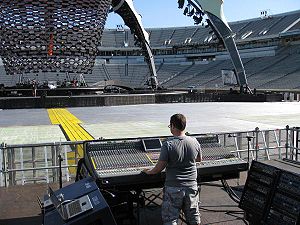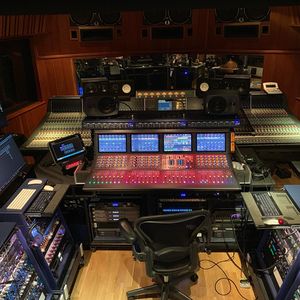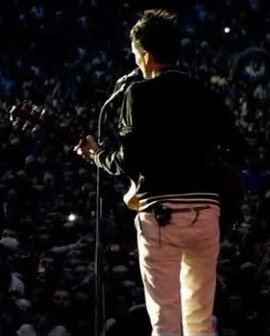Difference between revisions of "Other gear"
| Line 31: | Line 31: | ||
Muse's long time monitor engineer, Adam Taylor, used to use a Digidesign Profile desk (for Automation, Delay & Reverb purposes) and a Midas Heritage 3000. | Muse's long time monitor engineer, Adam Taylor, used to use a Digidesign Profile desk (for Automation, Delay & Reverb purposes) and a Midas Heritage 3000. | ||
Sometime during later tours he upgraded to a Midas Pro 9 | Sometime during later tours he upgraded to a Midas Pro 9. | ||
==PA System== | ==PA System== | ||
Revision as of 20:35, 2 June 2019
Backing tracks and click-tracks
Muse make increasing use of backing tracks when performing live. This is a recorded track that the band play along to in order to add extra layers to their music which cannot be played by only three people.
This includes, for example, the orchestral strings in "Butterflies & Hurricanes", the synthesizer arpeggio in Bliss and the "Now, I want it now" backing vocals in "Hysteria" are played by Morgan Nicholls.
To keep in time with this track, the band have a digital metronome – synchronised to the recording – playing through their In-Ear Monitors, which the audience do not hear. A click track is also used in some songs which do not have backing tracks in order to keep in time with synchronised guitar effects like delays, for example in "Sing For Absolution".
FOH console and rack
For a long time, FOH engineer Marc Carolan used a Midas XL4 and a Midas PRO 6 mixing desks along with a rack filled with:
- Empirical Labs Distressors and BSS Audio 901 multiband compressors for vocals;
- Dbx 160s on kick and snare;
- Tube-Tech LCA-2B on bass and guitars;
- Eventide H3000 for vocal processing;
- Yamaha SPX2000s for drum effects.
As of Autumn of 2018, he switched to a smaller, more compact Avid Venue S6L console, coupled with Midas XL4 pre-amps in three rack units. He still uses the outboard gear.
Monitors
In-ear monitors
All three band members use 'Westone' UM2 In-Ear Monitors (IEMs).
The whole purpose of In-Ear Monitoring is to reduce outside noise so that the artist can listen to the mix at comfortable levels thus saving his/her hearing, and as each set are custom made to fit their ear perfectly, over 20dB of isolation is given. The wireless transmitters used to be Sennheiser G3 300.[1]They've now upgraded to the Senheiser 2000 transmitters.[2]
Also, Dominic has two L-Acoustics dV-SUB subwoofers[3] sitting behind him to add more low end to his monitoring needs and Chris has two d&b J-SUBs for the same reason.[4][5]
Monitor console and rack
Muse's long time monitor engineer, Adam Taylor, used to use a Digidesign Profile desk (for Automation, Delay & Reverb purposes) and a Midas Heritage 3000.
Sometime during later tours he upgraded to a Midas Pro 9.
PA System
The PA system used for The Resistance Tour consists of d&b audiotechnik[6]:
- Main Array: J8/J12
- Centre Hang: Q1
- Subs: J-SUB
- Fill with Subs: Q10
- Amps: 96 D12 amps (digital in)
- A/D Conversion: Apogee Rosetta 800
- System Processor: Dolby Lake
Plectrum
- Main article: Plectrums
Maraca
Two maracas were used by Christopher Wolstenholme for the verse of "Endlessly" during the Absolution Tour.
Cabasa
Morgan Nicholls uses a cabasa during Supermassive Black Hole and Psycho, live. It was previously referred to as a "shaker" by fans, but when asked at the Royal Albert Hall gig on 12th April, 2008 he revealed that it was a cabasa. This has become a point of humour among Official Message Board members.
Llama toenails
Used on "Screenager" and "United States of Eurasia", on which Matt described them as being "back with a vengeance".[7]
Harmonica
Chris plays a Muse custom Lee Oskar harmonica, to play "Man With A Harmonica" as an intro to Knights of Cydonia. Before this, Chris was taping two Lee Oskar diatonic harmonicas together as one alone couldn't achieve all of the notes needed for the song.
References
- ↑ http://www.sennheiserusa.com/newsite/newspage.asp?transid=3264
- ↑ http://www.skanpa.co.uk/muse-the-2nd-law-world-tour-2012-14/
- ↑ http://www.l-acoustics-us.com/products-dv-sub-66.html
- ↑ http://muse.mu/gallery/official/photo/21827/
- ↑ http://muse.mu/images/official/photo/21824/
- ↑ http://www.dbaudio.com/en/articles/ft_out?num=/web/live/en/articles/long/muse_10
- ↑ Samantha Clode. (2009-06-24). Viva la Resistance!. jmag. Retrieved 2009-06-25 from www.muselive.com. [verify]
Back to Gear



